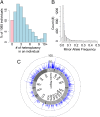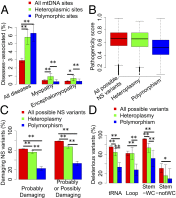Extensive pathogenicity of mitochondrial heteroplasmy in healthy human individuals
- PMID: 25002485
- PMCID: PMC4115537
- DOI: 10.1073/pnas.1403521111
Extensive pathogenicity of mitochondrial heteroplasmy in healthy human individuals
Abstract
A majority of mitochondrial DNA (mtDNA) mutations reported to be implicated in diseases are heteroplasmic, a status with coexisting mtDNA variants in a single cell. Quantifying the prevalence of mitochondrial heteroplasmy and its pathogenic effect in healthy individuals could further our understanding of its possible roles in various diseases. A total of 1,085 human individuals from 14 global populations have been sequenced by the 1000 Genomes Project to a mean coverage of ∼2,000× on mtDNA. Using a combination of stringent thresholds and a maximum-likelihood method to define heteroplasmy, we demonstrated that ∼90% of the individuals carry at least one heteroplasmy. At least 20% of individuals harbor heteroplasmies reported to be implicated in disease. Mitochondrial heteroplasmy tend to show high pathogenicity, and is significantly overrepresented in disease-associated loci. Consistent with their deleterious effect, heteroplasmies with derived allele frequency larger than 60% within an individual show a significant reduction in pathogenicity, indicating the action of purifying selection. Purifying selection on heteroplasmies can also be inferred from nonsynonymous and synonymous heteroplasmy comparison and the unfolded site frequency spectra for different functional sites in mtDNA. Nevertheless, in comparison with population polymorphic mtDNA mutations, the purifying selection is much less efficient in removing heteroplasmic mutations. The prevalence of mitochondrial heteroplasmy with high pathogenic potential in healthy individuals, along with the possibility of these mutations drifting to high frequency inside a subpopulation of cells across lifespan, emphasizes the importance of managing mitochondrial heteroplasmy to prevent disease progression.
Conflict of interest statement
The authors declare no conflict of interest.
Figures




Comment in
-
Reply to Just et al.: Mitochondrial DNA heteroplasmy could be reliably detected with massively parallel sequencing technologies.Proc Natl Acad Sci U S A. 2014 Oct 28;111(43):E4548-50. doi: 10.1073/pnas.1415171111. Epub 2014 Oct 15. Proc Natl Acad Sci U S A. 2014. PMID: 25319265 Free PMC article. No abstract available.
-
Questioning the prevalence and reliability of human mitochondrial DNA heteroplasmy from massively parallel sequencing data.Proc Natl Acad Sci U S A. 2014 Oct 28;111(43):E4546-7. doi: 10.1073/pnas.1413478111. Epub 2014 Oct 15. Proc Natl Acad Sci U S A. 2014. PMID: 25319266 Free PMC article. No abstract available.
Similar articles
-
Mitochondrial heteroplasmy in vertebrates using ChIP-sequencing data.Genome Biol. 2016 Jun 27;17(1):139. doi: 10.1186/s13059-016-0996-y. Genome Biol. 2016. PMID: 27349964 Free PMC article.
-
Presence and transmission of mitochondrial heteroplasmic mutations in human populations of European and African ancestry.Mitochondrion. 2021 Sep;60:33-42. doi: 10.1016/j.mito.2021.07.004. Epub 2021 Jul 21. Mitochondrion. 2021. PMID: 34303007 Free PMC article.
-
Mitochondrial DNA heteroplasmy in disease and targeted nuclease-based therapeutic approaches.EMBO Rep. 2020 Mar 4;21(3):e49612. doi: 10.15252/embr.201949612. Epub 2020 Feb 19. EMBO Rep. 2020. PMID: 32073748 Free PMC article. Review.
-
Maternal age effect and severe germ-line bottleneck in the inheritance of human mitochondrial DNA.Proc Natl Acad Sci U S A. 2014 Oct 28;111(43):15474-9. doi: 10.1073/pnas.1409328111. Epub 2014 Oct 13. Proc Natl Acad Sci U S A. 2014. PMID: 25313049 Free PMC article.
-
Mitochondrial Heteroplasmy.Adv Exp Med Biol. 2017;982:577-594. doi: 10.1007/978-3-319-55330-6_30. Adv Exp Med Biol. 2017. PMID: 28551808 Review.
Cited by
-
Mito-nuclear co-evolution: the positive and negative sides of functional ancient mutations.Front Genet. 2014 Dec 23;5:448. doi: 10.3389/fgene.2014.00448. eCollection 2014. Front Genet. 2014. PMID: 25566330 Free PMC article. Review.
-
Genetic Evidence for Elevated Pathogenicity of Mitochondrial DNA Heteroplasmy in Autism Spectrum Disorder.PLoS Genet. 2016 Oct 28;12(10):e1006391. doi: 10.1371/journal.pgen.1006391. eCollection 2016 Oct. PLoS Genet. 2016. PMID: 27792786 Free PMC article.
-
Assessing Mitochondrial DNA Variation and Copy Number in Lymphocytes of ~2,000 Sardinians Using Tailored Sequencing Analysis Tools.PLoS Genet. 2015 Jul 14;11(7):e1005306. doi: 10.1371/journal.pgen.1005306. eCollection 2015 Jul. PLoS Genet. 2015. PMID: 26172475 Free PMC article.
-
The Value of Whole-Genome Sequencing for Mitochondrial DNA Population Studies: Strategies and Criteria for Extracting High-Quality Mitogenome Haplotypes.Int J Mol Sci. 2022 Feb 17;23(4):2244. doi: 10.3390/ijms23042244. Int J Mol Sci. 2022. PMID: 35216360 Free PMC article.
-
Mitochondrial Heterogeneity.Front Genet. 2019 Jan 25;9:718. doi: 10.3389/fgene.2018.00718. eCollection 2018. Front Genet. 2019. PMID: 30740126 Free PMC article. Review.
References
-
- Wallace DC. Mitochondrial DNA mutations in disease and aging. Environ Mol Mutagen. 2010;51(5):440–450. - PubMed
Publication types
MeSH terms
Substances
Grants and funding
LinkOut - more resources
Full Text Sources
Other Literature Sources
Medical

